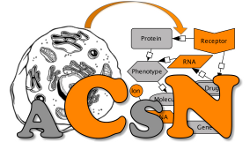1- ACSN purpose
2- ACSN features
3- ACSN structure
4- Video tutorial
5- NaviCell technology
6- Visualization and analysis of "-omics" data using ACSN
7- Visualization of high-throughput cancer datasets on ACSN maps
ACSN purpose
There are numerous dysregulated cell signalling mechanisms in cancer. To understand involvement of and crosstalk between different mechanisms in disease initiation and development, systematic representation of processes is needed. To achieve the goal, we have initiated the construction of the Atlas of Cancer Signaling Networks (ACSN). ACSN aims to cover a majority of molecular processes implicated in cancer. ACSN signalling networks maps are manually created and annotated using systems biology standards. The content of the maps is curated by specialists in the corresponding fields.
ACSN features
ACSN maps are cancer-specific
ACSN aims to collect, organize and graphically represent non-disease molecular mechanisms lying behind well defined cancer hallmarks (Hanahan and Weinberg). ACSN concentrates on exhaustive representation of molecular mechanisms that are frequently dysregulated in cancer such as cell cycle, DNA repair, cell death, survival, immune response signalling, telomere maintenance and others.
ACSN maps are interconnected
ACSN signalling maps create a ‘geographical-like’ view of cancer signalling, but, unlike geography, the same molecular entity can participate in several pathways, connecting them together, and this is reflected explicitly in ACSN. To keep track of canonically-defined pathways, signalling pathways are indicated on the maps as functional modules and can be visualized in the context of the whole network or as separate maps.
ACSN maps are systematic and detailed
The maps are manually created based on the information extracted from scientific literature. Maps are constructed using the Systems Biology Graphical Notation standard with the CellDesigner tool . Each map contains information about interactions between proteins, protein modifiers, post-translational modifications, protein complexes, genes, RNAs, microRNAs, small molecules and drugs. ACSN maps are reaction networks represented using process diagram description graphical language. Each map covers hundreds of molecular players and reactions; each entity on the map is annotated by references to the article and specific notes added by the map manager.
ACSN structure
ACSN is constructed as a global ‘geographical atlas’ of cancer signalling. The atlas consists of a global "world map", maps of "continents", each representing a particular cellular function (e. g. Cell Cycle or Apoptosis). Each continent map is sub-divided into "countries" or functional modules representing signalling pathways (e.g. WNT pathway or Homologous recombination pathway).
ACSN zoom levels
The atlas can be view at several zoom levels. To facilitate the exploration, each level of zoom on the atlas exposes a certain depth of detail. The top-level view shows the general architecture of the atlas. The next zoom exposes locations of known oncogenes or tumor supressors. The third zoom level adds some of the most participating proteins and complexes in the atlas. Furthermore, two zooms visualize components of the atlas and reaction edges between them. Finally at the most detailed zoom level all details of maps are demonstrated including names of all entities, post-translational modifications, complexes’ names, reactions IDs and all regulators and catalyzer of reactions.
ACSN Documentation & help
What types of questions ACSN can help to answer?
Examples:- Is my favorite molecule on the ACSN?
- How frequently do I find my favorite molecule on the ACSN?
- In what ACSN maps do I find my favorite molecule?
- In what modules of ACSN maps do I find my favorite molecule?
- In how many reactions does my favorite molecule participates?
- What reactions does my favorite molecule catalyses or regulates?
- What type of regulation does my favorite molecule performs?
- How can I learn about some signalling process of pathways on ACSN?
- What are the participants and what reactions are in a particular signalling process?
- How do I learn more about my favorite molecule, do I have access to additional databases?
Video tutorial
![]() Watch ACSN video tutorial on YouTube
Watch ACSN video tutorial on YouTube
Browsing and commenting ACSN via the NaviCell tool
The ACSN map navigation, curation and maintenance are enabled by a user friendly Google Maps-based tool NaviCell. The tool is characterized by the unique combination of three essential features: (1) map navigation based on Google Maps engine, (2) semantic zooming for viewing different levels of details of the map and (3) integrated web-based blog for collecting the community curation feedbacks.
Access to Navicell tool guide.
Visualization and analysis of "-omics" data using ACSN
The visualization module is a set of functions that can be used to visualize various types of "omics" data on the ACSN molecular maps. It is available at the bottom of the right-hand panel on the ACSN maps browsing interface.
- ACSN Omics Data Visualization and Analysis Guide
- Data files for the examples cited in the ACSN Omics Data Visualization and Analysis Guide
- Interactive demo ("Live Example") of using "-omics" data in ACSN
- Example: Visualizing transcriptomic data from prostate cancer cell lines
- Example: Visualizing TCGA ovarian cancer data using ACSN
- Advanced use of NaviCell Web Service for data visualization
Visualization of high-throughput cancer datasets on ACSN maps
 NaviCom is a platform for generating
interactive network based molecular portraits using high-throughput datasets.
It connects the cBioPortal database and NaviCell web service and allows to
display various high-throughput data types simultaneously on the network maps
in one click.
NaviCom is a platform for generating
interactive network based molecular portraits using high-throughput datasets.
It connects the cBioPortal database and NaviCell web service and allows to
display various high-throughput data types simultaneously on the network maps
in one click.

